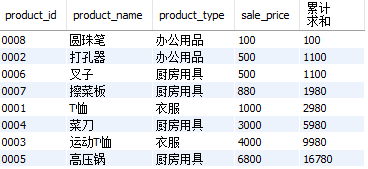
找出 product 和 product2 中售价高于 500 的商品的基本信息。
解答:
select * from product where sale_price > 500
union
select * from product2 where sale_price > 500;
运行结果:

借助对称差的实现方式, 求product和product2的交集。
解答:
由于 mysql 中只能使用 union, 因此根据题意构造
set (product - product2) U set (product2 - product) 来得到对称差:
select * from product where product_id not in (select product_id from product2)
union
select * from product2 where product_id not in (select product_id from product);
再根据 set (product) U set (product2) - set ( 对称差 ) 来得到交集:
select * from (select * from product union select * from product2) as u
where product_id not in (
select product_id from product where product_id not in (select product_id from product2)
union
select product_id from product2 where product_id not in (select product_id from product)
);
运行结果:

此结果与子查询直接求交集的结果相同
select * from product where product_id in (select product_id from product2);

每类商品中售价最高的商品都在哪些商店有售 ?
解答:
可以先将 product 表与 shoppproduct 表连以 product_id 相同为条件作内连结:
select sp.shop_id, sp.shop_name, sp.quantity,
p.product_id, p.product_name, p.product_type, p.sale_price
from product as p
inner join shopproduct as sp
on sp.product_id = p.product_id;
再将 product 表中每种类别的最大价格筛选出来:
select product_type, max(sale_price) as maxp from product
group by product_type
最后再根据类别和价格相等作为条件连结到下面:
select sp.shop_id, sp.shop_name, sp.quantity,
p.product_id, p.product_name, p.product_type, p.sale_price,
mp.maxp as '该类商品的最大售价'
from product as p
inner join shopproduct as sp
on sp.product_id = p.product_id
inner join (
select product_type, max(sale_price) as maxp from product
group by product_type
) as mp
on mp.product_type = p.product_type and p.sale_price = mp.maxp;
运行结果:

分别使用内连结和关联子查询每一类商品中售价最高的商品。
解答:
内连结方式与上题相同:
select p.product_id, p.product_name, p.product_type, p.sale_price
from product as p
inner join (
select product_type, max(sale_price) as maxp from product
group by product_type
) as mp
on mp.product_type = p.product_type and p.sale_price = mp.maxp;
运行结果:

关联子查询方式与教程中的类似:
select p.product_id, p.product_name, p.product_type, p.sale_price
from product as p
where sale_price = (
select max(sale_price) from product as p1
where p.product_type = p1.product_type
group by product_type
);
运行结果:

用关联子查询实现:在product表中,取出 product_id, product_name, slae_price, 并按照商品的售价从低到高进行排序、对售价进行累计求和。
解答:
关联子查询整体结构同上题
select p.product_id, p.product_name, p.product_type, p.sale_price
from product as p
where sale_price = (
select max(sale_price) from product as p1
where p.product_type = p1.product_type
group by product_type
);
本题中需要关联的条件是 sale_price,因此可以更改上面的关联子查询条件:
p.product_type = p1.product_type ---更改为---> p.sale_price >= p1.sale_price
同样的,由于教程中已经提及过的问题,即存在两个商品的 sale_price 相同,上述语句的结果可能会不准确,这一点后续再讨论。
下一步,由于不能用连结方式扩充列,因此需要将关联子查询放入 select 子句中以增加“累计求和“列:
select p.product_id, p.product_name, p.product_type, p.sale_price,
(select sum(sale_price) from product as p1
where p.sale_price >= p1.sale_price
) as '累计求和'
from product as p
order by sale_price;
此时可以得到如下的结果:

要解决那两个重复值的问题,按照关联子查询的逻辑,
当 p.sale_price 中传递给子查询 “0008 号的 100(sale_price)” 时,在 p1 中满足 p.sale_price >= p1.sale_price 条件的只有 0008 号,因此 sum(sale_price) 只会计算 0008 号的 sale_price 一个值;
当 p.sale_price 中传递给子查询 “0002 号的 500(sale_price)” 时,在 p1 中满足 p.sale_price >= p1.sale_price 条件的有 0008 号、0002 号、0006 号,因此 sum(sale_price) 只会计算 0008、0002、0006 号的三个 sale_price 值;传递 0006 号时同理;
需要解决的问题是,当 sale_price 相同但 product_id 不同时的统计先后问题,与教程中类似,可以增加一个关于 product_id 的条件
p.sale_price >= p1.sale_price ---更改为--->
p.sale_price > p1.sale_price
or (p.sale_price = p1.sale_price and p.product_id >= p1.product_id)
此时当 p.sale_price 中传递给子查询 “0002 号的 500(sale_price)” 时,在 p1 中
满足 p.sale_price > p1.sale_price 条件的有 0008 号;
满足 p.sale_price = p1.sale_price 条件的有 0002 号、0006 号;
满足 p.product_id >= p1.product_id 条件的只有 0002 号,
因此 sum(sale_price) 只会计算 0008、0002 号的两个 sale_price 值;
同理传递 0006 号时,由于满足 p.product_id >= p1.product_id 条件的有 0002 号、0006 号 (0006>=0006, 0006>=0002) 因此会计算 0008、0002、0006 号三个 sale_price 值,即可以得到正确结果。
最终查询语句如下:
select p.product_id, p.product_name, p.product_type, p.sale_price,
(select sum(sale_price) from product as p1
where p.sale_price > p1.sale_price
or (p.sale_price = p1.sale_price and p.product_id >= p1.product_id)
) as '累计求和'
from product as p
order by sale_price;
运行结果:

Javascript基础 Javascript冒泡排序 原理 Demo function score ( arr ) { for ( ...
经常有朋友问起,如何在IM即时通讯中实现发送图片、视频、语音和表情? 为此,小...
我们只需要简单地打开任意文本编辑器,将下面的代码复制进去,然后保存文件,例...
Prometheus Operator默认的监控指标并不能完全满足实际的监控需求,这时候就需要...
目录 脚本说明 脚本内容 使用 使用示例 参考与引用 脚本说明 这是专门为本地调试...
那么到底在GIF,PNG,JPG这些格式我们要选择哪一种作为候选格式,而哪种图片格式可...
新闻发布系统 1. 系统简介 一个简单的新闻系统,包含了四个功能,增删改查,利用...
凭记忆简单记录一下遇到的一些面试题。 时间线数量 2021.04.022家 2021.04.063家...
目录 算法 什么是算法 算法的特点 算法的历史 算法的描述 自然语言案例 流程图 3...
简易文字小游戏 在学习了一些C#的基础知识后就要做一些小东西来练练手就比如本文...